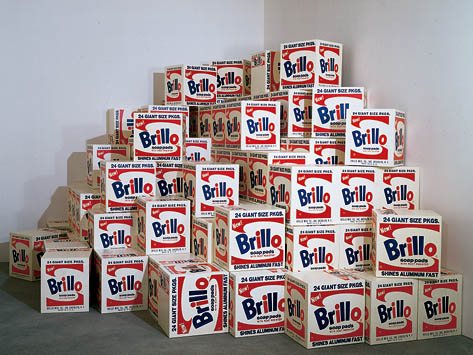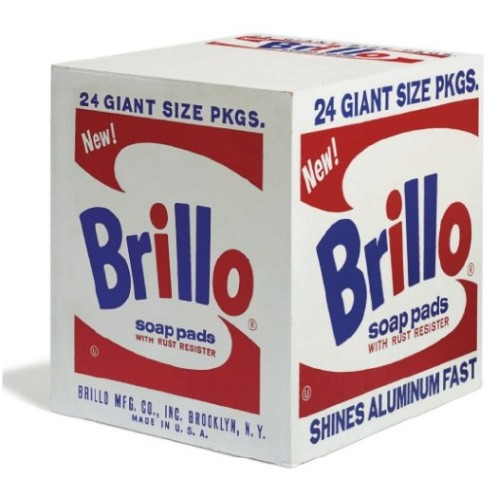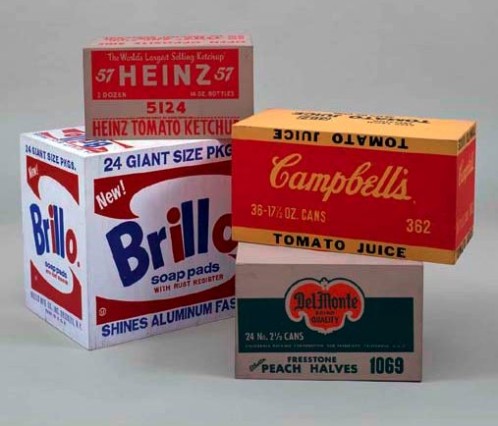Andy Warhol
‚Brillo Boxes‘
Key Pieces series
After shocking the world in 1962 with his famous Campbell’s Soup silkscreens, Andy Warhol surprised the art world a couple of years later with his Brillo Boxes which are our Key Pieces of the week.
1. They are wood sculptures with silkscreen prints.
2. The Brillo Boxes embody one of America’s most typical product: soap pads from Brillo used for cleaning dishes.
3. They were first shown in 1964 at the Stable Gallery in Manhattan.
4. Arthur Danto, a Warhol expert, said, he felt like witnessing ‘the end of western art’ when walking out of the exhibition.
5. The series begun when Warhol asked his assistant Gerard Malanga to buy ordinary items at the supermarket to raise questions concerning the way we identify and value something as art. Malanga came back with Campbell soups, Del Monte caned peaches and Brillo soap boxes.
6. Warhol’s Brillo Boxes are precise copies of the original ones.
7. At first sight, the finished original sculptures are indistinguishable from their cardboard supermarket counterparts.
8. The Brillo Boxes are empty, filled with nothing but air.
9. Curator Pontus Hulten created close to a hundred Brillo Boxes for a retrospective at the Moderna Museet in 1995. The Boxes were therefore created after Warhol’s death which give way to a scandal when the story was discovered.
10. The first Brillo Boxes were difficult to sell as Eleanor Ward, art dealer at the Stable Gallery, mentioned. The first Boxes ranged from $200 to $400 in 1964. Until today, their value increased extraordinary. In 2006 a Brillo Box was sold for $710’000 at Christies’ New York.


Andy Warhol, Brillo Box, 1964, Screenprint and ink on wood, 17 x 17 x 14 inches (43.2 x 43.2 x 35.6 cm)

Andy Warhol, Brillo, Campbell, Del Monte and Heinz Boxes, 1964, Screenprint and ink on wood.
Archive
- Dezember 2016 (1)
- Oktober 2016 (3)
- September 2016 (24)
- Juli 2016 (20)
- Juni 2016 (24)
- Mai 2016 (18)
- April 2016 (18)
- März 2016 (21)
- Februar 2016 (11)
- Januar 2016 (20)
- Dezember 2015 (20)
- November 2015 (37)
- Oktober 2015 (30)
- September 2015 (24)
- August 2015 (4)
- Juli 2015 (30)
- Juni 2015 (9)
- Mai 2015 (17)
- April 2015 (23)
- März 2015 (18)
- Januar 2015 (8)
- Dezember 2014 (1)
- November 2014 (3)
- Oktober 2014 (10)
- September 2014 (4)
- August 2014 (2)
- Juli 2014 (3)
- Juni 2014 (2)
- Mai 2014 (5)
- April 2014 (11)
- März 2014 (12)
- Februar 2014 (13)
- Januar 2014 (10)
- Dezember 2013 (5)
- November 2013 (13)
- Oktober 2013 (24)
- September 2013 (18)
- August 2013 (26)
- Juli 2013 (13)
- Juni 2013 (35)
- Mai 2013 (44)
- April 2013 (49)
- März 2013 (61)
- Februar 2013 (54)
- Januar 2013 (46)
- Dezember 2012 (50)
- November 2012 (58)
- Oktober 2012 (62)
- September 2012 (61)
- August 2012 (63)
- Juli 2012 (64)
- Juni 2012 (61)
- Mai 2012 (63)
- April 2012 (51)
- März 2012 (67)
- Februar 2012 (37)



